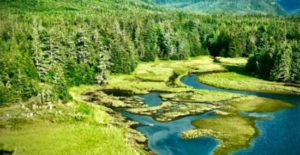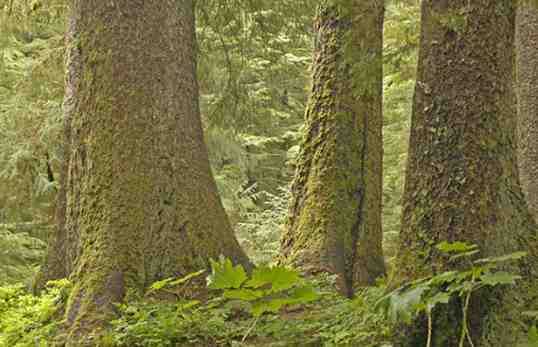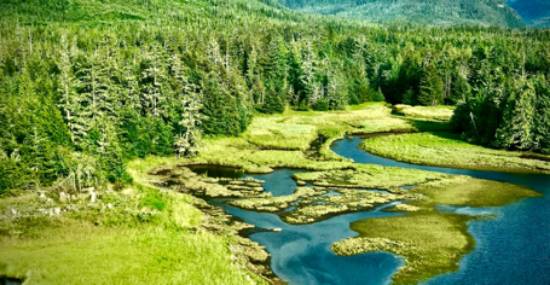 Talent, OR and Falmouth, MA –Scientists from Wild Heritage and Woodwell Climate Research Center used the latest data on carbon stored in forests to document the importance of the Tongass rainforest in southeast Alaska as a natural climate solution. This single 16.5 million-acre national forest, the largest of the national forests, stores approximately 20% of the carbon in the entire national forests system. The team compiled data on plant biomass and soil carbon stocks derived from published sources, including over 1,000 plots in the USDA Forest Service Forest Inventory and Analysis network at a scale of 30-m (100-ft) pixels. The total carbon stock was then summarized for old growth, young growth, Inventoried Roadless Areas, and 77 priority watersheds for fish and wildlife known as the Tongass 77. The Tongass contains the highest concentration of old-growth rainforests (5.1 million acres) and roadless areas (9.1 million acres) in the nation.
Talent, OR and Falmouth, MA –Scientists from Wild Heritage and Woodwell Climate Research Center used the latest data on carbon stored in forests to document the importance of the Tongass rainforest in southeast Alaska as a natural climate solution. This single 16.5 million-acre national forest, the largest of the national forests, stores approximately 20% of the carbon in the entire national forests system. The team compiled data on plant biomass and soil carbon stocks derived from published sources, including over 1,000 plots in the USDA Forest Service Forest Inventory and Analysis network at a scale of 30-m (100-ft) pixels. The total carbon stock was then summarized for old growth, young growth, Inventoried Roadless Areas, and 77 priority watersheds for fish and wildlife known as the Tongass 77. The Tongass contains the highest concentration of old-growth rainforests (5.1 million acres) and roadless areas (9.1 million acres) in the nation.
According to Dr. Dominick DellaSala, lead author on the paper, “old-growth forests on the Tongass store the equivalent of 1.5 times the nation’s total annual carbon pollution (ca. 2019), locking it away long term in ancient trees and soils.” DellaSala is on a team of international scientists currently documenting the importance of primary, unlogged forests world-wide. DellaSala added, “our findings reinforce the president’s remarks on Earth Day that older forests are the lungs of the planet and are key to forestalling severe climate impacts.”
On Earth Day, President Joe Biden issued an Executive Order directing federal agencies to conduct a science-based inventory of the nation’s mature and old-growth. The president also directed federal agencies to protect 30% of the nation’s lands and waters by 2030 (30 x 30).
“There are few places remaining on the planet where temperate rainforests are this intact and are as well positioned to help the planet mitigate climate change while also meeting the needs of local communities and wildlife,” stated study co-author Dr. Wayne Walker. “The Tongass is a very special climate refuge and its old-growth forests and roadless areas should be managed as an interconnected carbon reserve network.”
The main findings reported in the peer-reviewed journal Land indicate:
- The majority (75%) of the forest carbon on the Tongass is held in roadless areas and old-growth rainforests. A small portion is in previously logged and roaded young forests.
- The Tongass 77 stores about 15% of the total carbon, most of which overlaps with old growth areas that support relatively abundant fish and wildlife species.
Logging on the Tongass began ca. 1909 and remained relatively low until 1947 when two 50-year timber pulp contracts were signed, resulting in a 15-fold increase in logging levels mainly targeting the largest, oldest trees. After termination of the pulp contracts in 2000, logging declined precipitously, reaching its lowest levels in 2019. The transition period from 2016-2100 is anticipated to shift logging into young-growth forests where carbon reserves are lowest. Carbon dioxide emissions track logging levels with highest emissions (>1 million metric tons CO2) released annually during the 1970s and lowest in 2021 (0.2 million metric tons). Emissions are projected to remain at nearly 0.3 million tons CO2 annually by the end of the century.
“The Tongass contains 16% of the nation’s roadless areas and is one of the most carbon-dense forests in the National Forest system,” according to study co-author, Seth Gorelik. “During a time when we are striving to rapidly cut greenhouse gas emissions, we need federally mandated protection of the Tongass now more than ever.”
The study recommended protecting remaining old-growth forests, roadless areas, and the Tongass 77 priority watersheds while saving the young growth within roadless areas to recapture carbon emitted from past logging. The predominant amount of young-growth forest available to support the timber transition is within already roaded and previously logged forests that have naturally reforested and can meet timber supply needs. [content id=”79272″]





